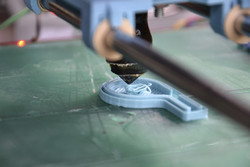New lasers offer low cost industrial processing and novel surgical possibilities
EU-funded scientists have developed efficient new fibre optic lasers that deliver short wavelengths for accurate polymer material processing, at incredible strength and low cost. The consortium behind the new innovations, developed through the ISLA project, is now in the process of marketing some of these cutting edge devices. Polymers – which are lightweight yet strong – are used in numerous industries ranging from aerospace to chemicals. Industrial lasers are used to slice and shape polymer materials for use in everything from laptops to solar panels. Global competition has placed increasing pressure on profit margins, pushing manufacturers to constantly innovate in areas of product performance and production efficiency. It is this industrial need that ISLA sought to address. The new fibre lasers developed by ISLA are just as powerful as devices currently on the market, and most importantly offer cost-competitive production. While welding, cutting and marking of plastics without the need for absorption-enhancing additives present the most obvious commercial opportunities for these fibre lasers, the success of ISLA should also open up potential new applications in other industrial sectors, such as surgery and optical coherence tomography (OCT) imaging. In surgery, light can be delivered through a flexible fibre and be easily integrated into devices such as endoscopes and microscopes. The targeted nature of the laser beam is also attractive to many surgeons, enabling them to access tricky areas of the body and deliver targeted cutting while minimising damage to surrounding tissue. The treatment of varicose veins and tumour resection are two possible uses. OCT imaging systems on the other hand are used in diverse range of sectors including art conservation and diagnostic medicine. The imaging technique is used to uncover more detail in layers beneath oil paintings than is possible with shorter-wavelength sources. Recently the technology has also begun to be used in interventional cardiology to help diagnose coronary artery disease. While commercial fibre lasers are already available on the market, the ground-breaking components delivered by ISLA mean that lasers may soon by far more cost competitive. The ISLA consortium also successfully developed a new graphene-based mode-locker. Mode-locking is a technique in optics by which a laser can be made to produce pulses of light of extremely short duration. Potential applications of this laser technique include optical data storage and eye surgery. Although the project was officially completed in June 2015, characterisation work is ongoing. Once this is finished, the laser will be transferred for industrial testing at an applications laboratory in Hamburg, Germany. ISLA consortium members will also take part in a dedicated session at the LASE conference, part of SPIE’s Photonics West event in San Francisco in February 2016. For further information, please visit: ISLA project website
Countries
United Kingdom



